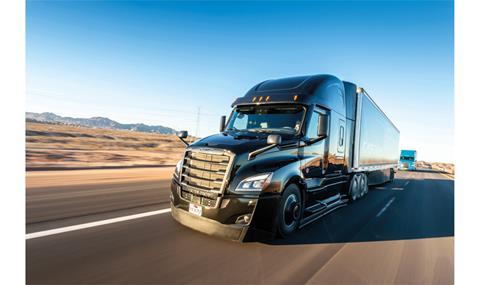
Daimler is to invest €500m (£450m) to develop a level 4 autonomous truck, with a view to bringing it to market within a decade.
Speaking at the North American launch of the new Freightliner Cascadia earlier this month, which has the same level 2 autonomy as the new Mercedes-Benz Actros, Daimler Trucks & Buses CEO Martin Daum said: “With the new Cascadia we have reached level 2, but now we plan to skip level 3 and target level 4 instead.”
He explained that with level 3, while drivers can take their hands off the steering wheel, they must always remain alert and be ready to take back full control at a moment’s notice.
“This means higher technology cost and investment, without corresponding benefits for the customer,” he said.
With level 4 autonomy, the truck is in full control, and in some cases the driver may not even be present in the cab.
“The biggest inefficiency we have in this industry is that we have a very expensive piece of equipment that can be used only 10 hours a day. If the driver could sleep [while the truck drove] it would be a different story,” said Daum. “Highly automated trucks will offer a strong value proposition for customers. They will cut cost per mile considerably.”
Read more
- DfT remains fully committed to UK platoon truck trial this spring
- Daimler turns back on truck platooning but still sees an autonomous future
- The opportunities and challenges of autonomous trucks and the UK platoon trial
But he acknowledged that highly automated driving “is no easy undertaking”, highlighting the technology involved.
“It is very complex, it has to work accurately in every circumstance, and it must work for five years and 500,000 miles,” he added. He cited public acceptance and a regulatory framework as further challenges.
As part of the investment in autonomy, Daimler will add 200 employees, many based at its Automated Truck R&D Centre in Portland, Oregon.
“We will initially have a regional focus in the US, and for good reason too,” explained Daum. “There is an excellent infrastructure, homogeneous traffic flow due to very similar speed limits for cars and trucks, and large distances.”
But he stressed that while the development will largely take place in North America, the technology will be shared across all of the truck brands. Daum said the initial focus will be hub-to-hub, on specific routes with wide lanes, away from urban areas, thus avoiding interaction with pedestrians and cyclists.
“It’s our aspiration to bring this technology to the road within a decade. But we want to put a level 4 [prototype] truck on the road this year. Stay tuned,” he said.














